PEUGEOT 4C 2015 Owners Manual
Manufacturer: PEUGEOT, Model Year: 2015, Model line: , Model:Pages: 348, PDF Size: 3.76 MB
Page 261 of 348
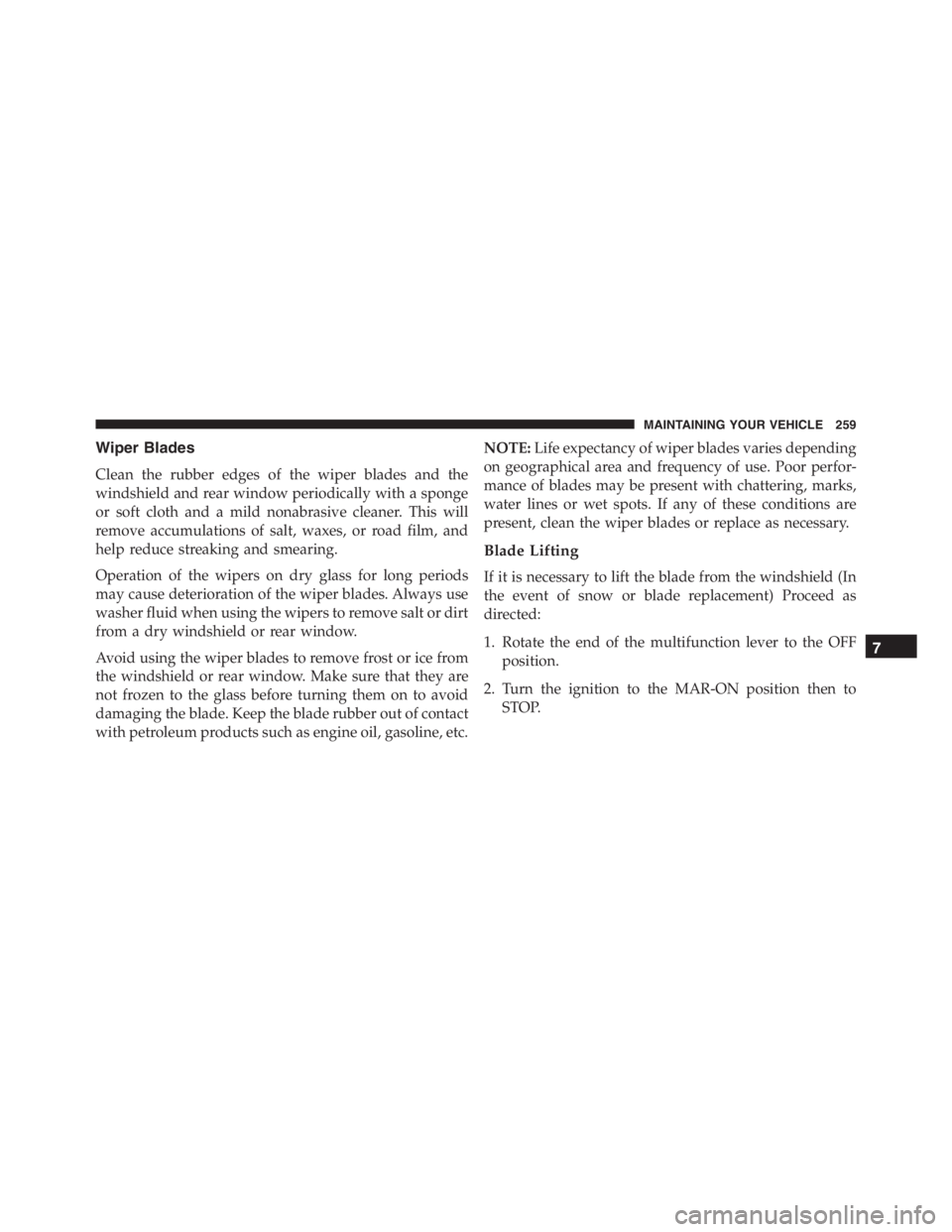
Wiper Blades
Clean the rubber edges of the wiper blades and the
windshield and rear window periodically with a sponge
or soft cloth and a mild nonabrasive cleaner. This will
remove accumulations of salt, waxes, or road film, and
help reduce streaking and smearing.
Operation of the wipers on dry glass for long periods
may cause deterioration of the wiper blades. Always use
washer fluid when using the wipers to remove salt or dirt
from a dry windshield or rear window.
Avoid using the wiper blades to remove frost or ice from
the windshield or rear window. Make sure that they are
not frozen to the glass before turning them on to avoid
damaging the blade. Keep the blade rubber out of contact
with petroleum products such as engine oil, gasoline, etc.NOTE:Life expectancy of wiper blades varies depending
on geographical area and frequency of use. Poor perfor-
mance of blades may be present with chattering, marks,
water lines or wet spots. If any of these conditions are
present, clean the wiper blades or replace as necessary.
Blade Lifting
If it is necessary to lift the blade from the windshield (In
the event of snow or blade replacement) Proceed as
directed:
1. Rotate the end of the multifunction lever to the OFF
position.
2. Turn the ignition to the MAR-ON position then to
STOP.
7
MAINTAINING YOUR VEHICLE 259
Page 262 of 348
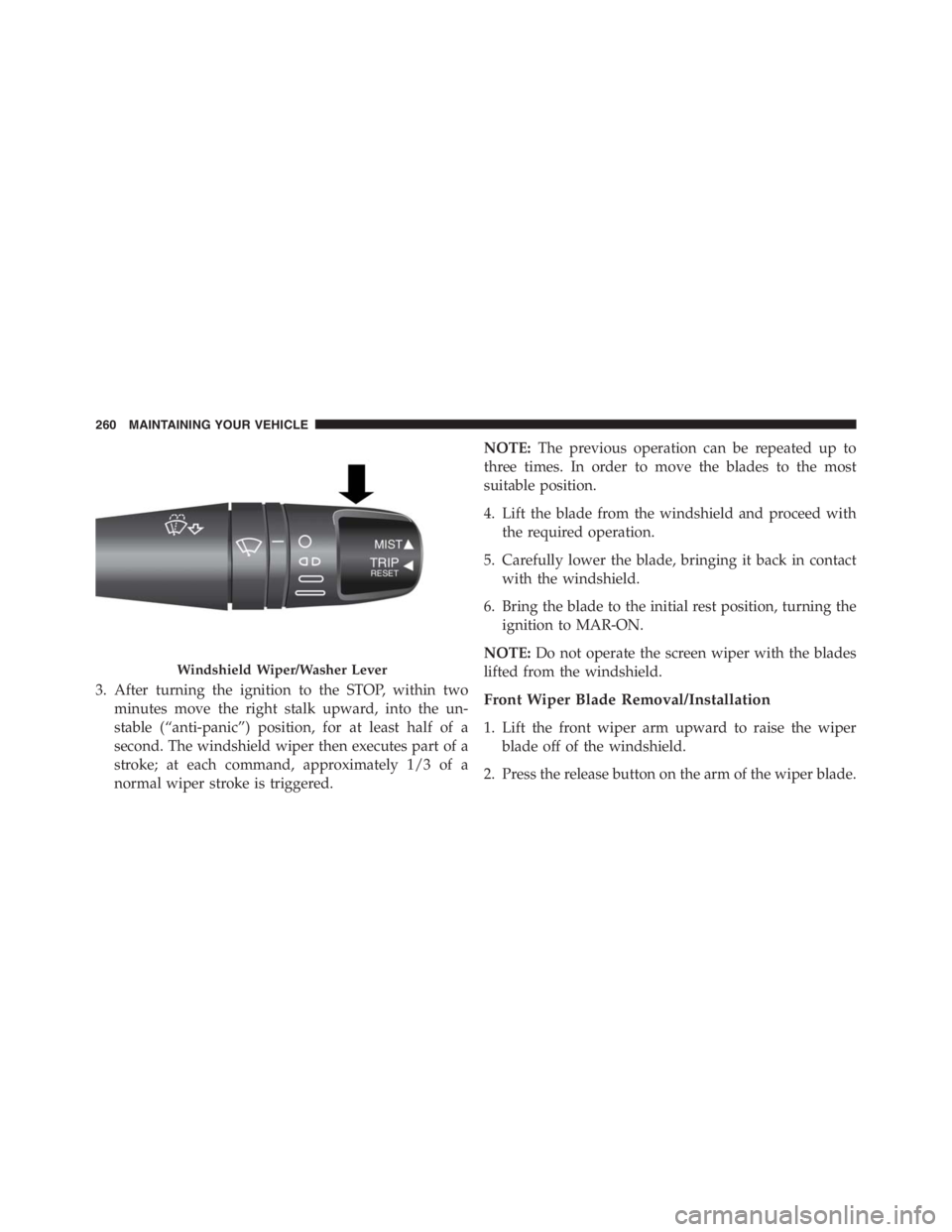
3. After turning the ignition to the STOP, within two
minutes move the right stalk upward, into the un-
stable (“anti-panic”) position, for at least half of a
second. The windshield wiper then executes part of a
stroke; at each command, approximately 1/3 of a
normal wiper stroke is triggered.NOTE:The previous operation can be repeated up to
three times. In order to move the blades to the most
suitable position.
4. Lift the blade from the windshield and proceed with
the required operation.
5. Carefully lower the blade, bringing it back in contact
with the windshield.
6. Bring the blade to the initial rest position, turning the
ignition to MAR-ON.
NOTE:Do not operate the screen wiper with the blades
lifted from the windshield.Front Wiper Blade Removal/Installation
1. Lift the front wiper arm upward to raise the wiper
blade off of the windshield.
2. Press the release button on the arm of the wiper blade.
Windshield Wiper/Washer Lever
260 MAINTAINING YOUR VEHICLE
Page 263 of 348
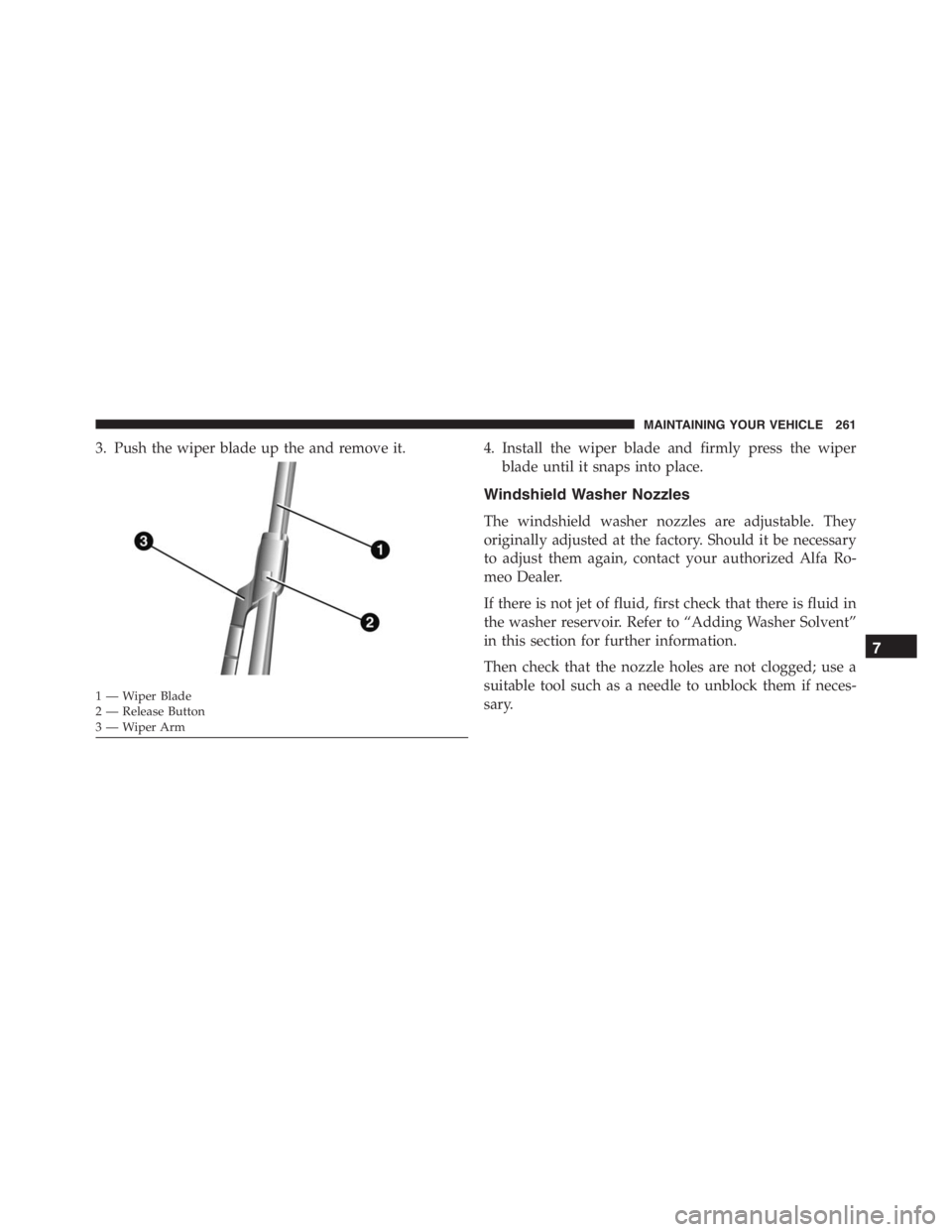
3. Push the wiper blade up the and remove it. 4. Install the wiper blade and firmly press the wiper
blade until it snaps into place.
Windshield Washer Nozzles
The windshield washer nozzles are adjustable. They
originally adjusted at the factory. Should it be necessary
to adjust them again, contact your authorized Alfa Ro-
meo Dealer.
If there is not jet of fluid, first check that there is fluid in
the washer reservoir. Refer to “Adding Washer Solvent”
in this section for further information.
Then check that the nozzle holes are not clogged; use a
suitable tool such as a needle to unblock them if neces-
sary.
1—WiperBlade
2 — Release Button
3—WiperArm
7
MAINTAINING YOUR VEHICLE 261
Page 264 of 348
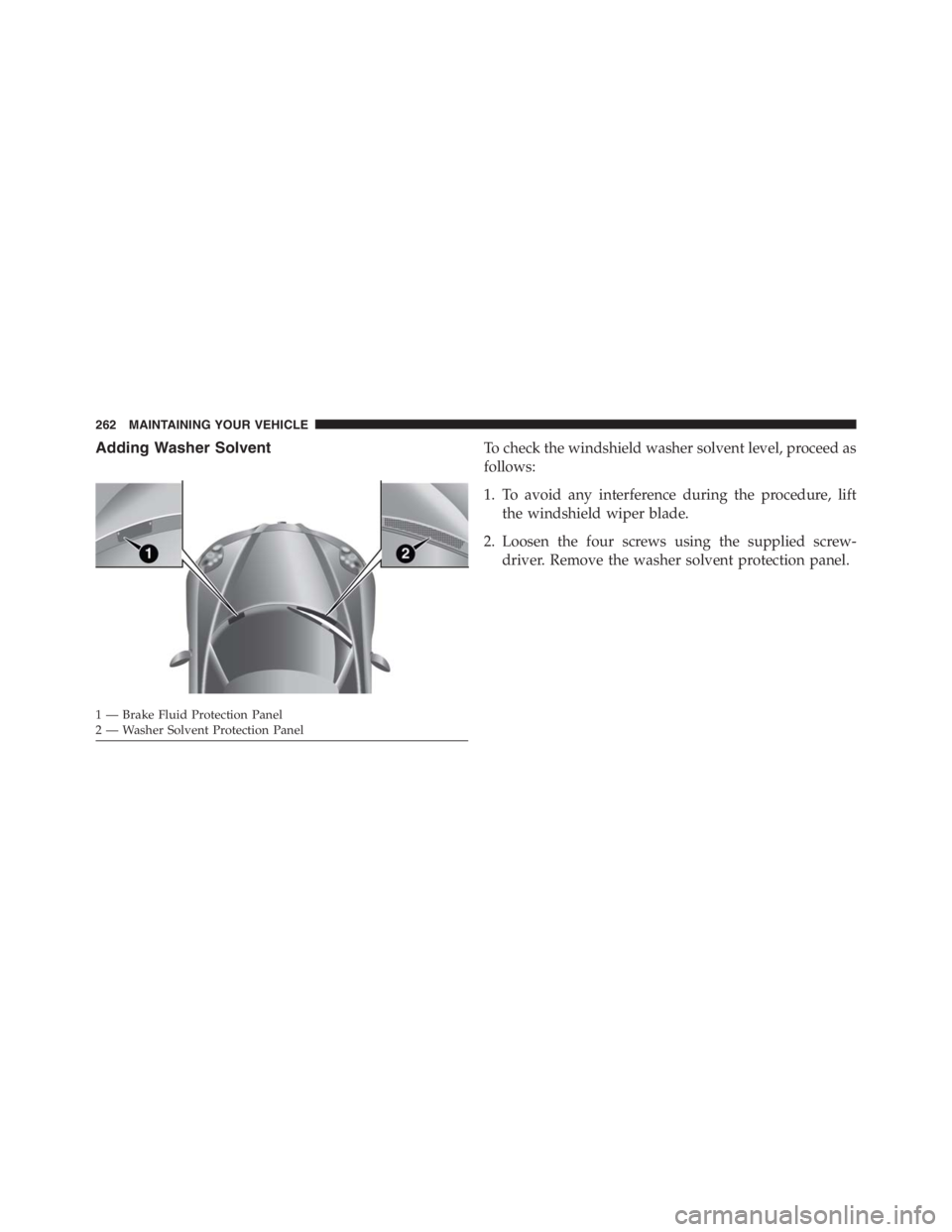
Adding Washer SolventTo check the windshield washer solvent level, proceed as
follows:
1. To avoid any interference during the procedure, lift
the windshield wiper blade.
2. Loosen the four screws using the supplied screw-
driver. Remove the washer solvent protection panel.
1 — Brake Fluid Protection Panel
2 — Washer Solvent Protection Panel 262 MAINTAINING YOUR VEHICLE
Page 265 of 348
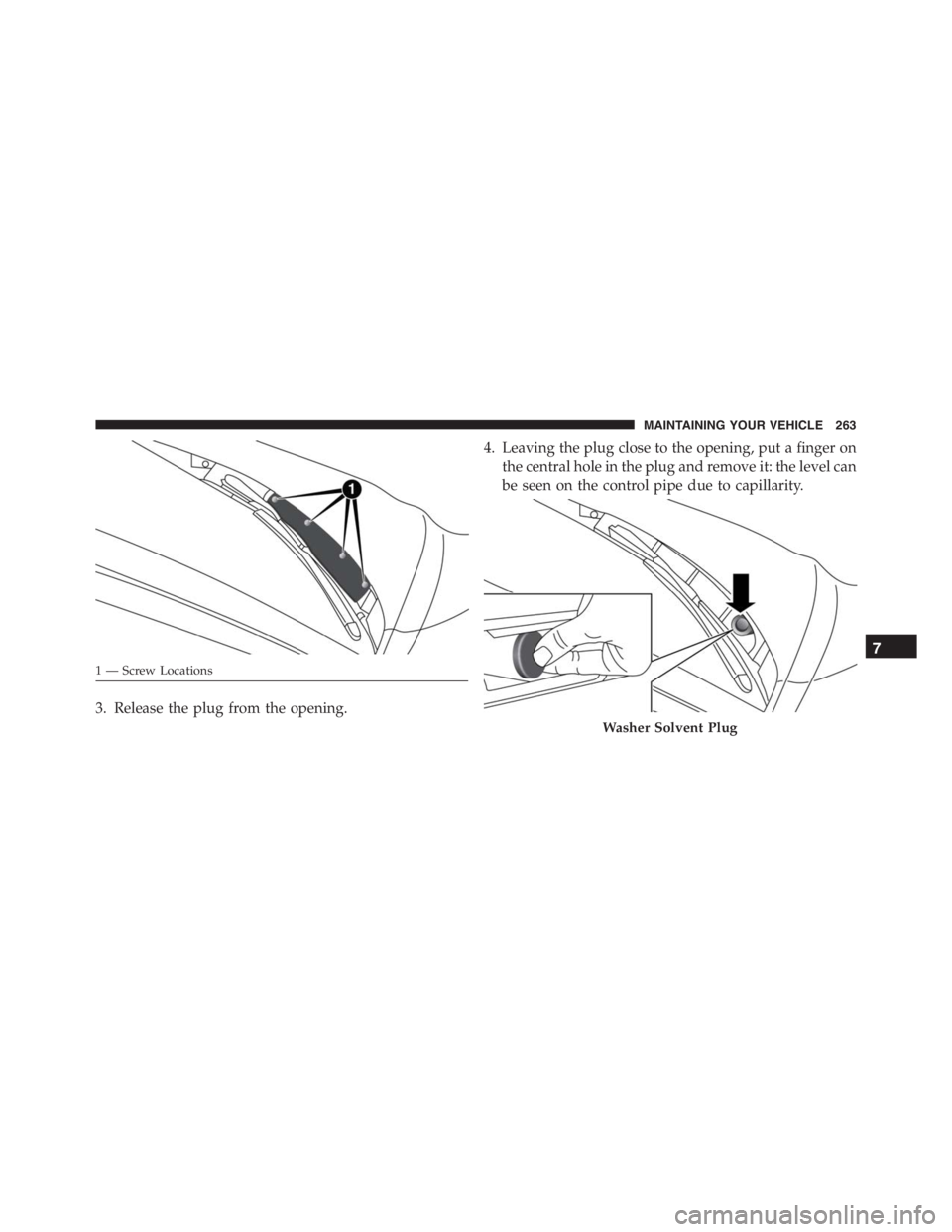
3. Release the plug from the opening.4. Leaving the plug close to the opening, put a finger on
the central hole in the plug and remove it: the level can
be seen on the control pipe due to capillarity.
1 — Screw Locations
Washer Solvent Plug
7
MAINTAINING YOUR VEHICLE 263
Page 266 of 348
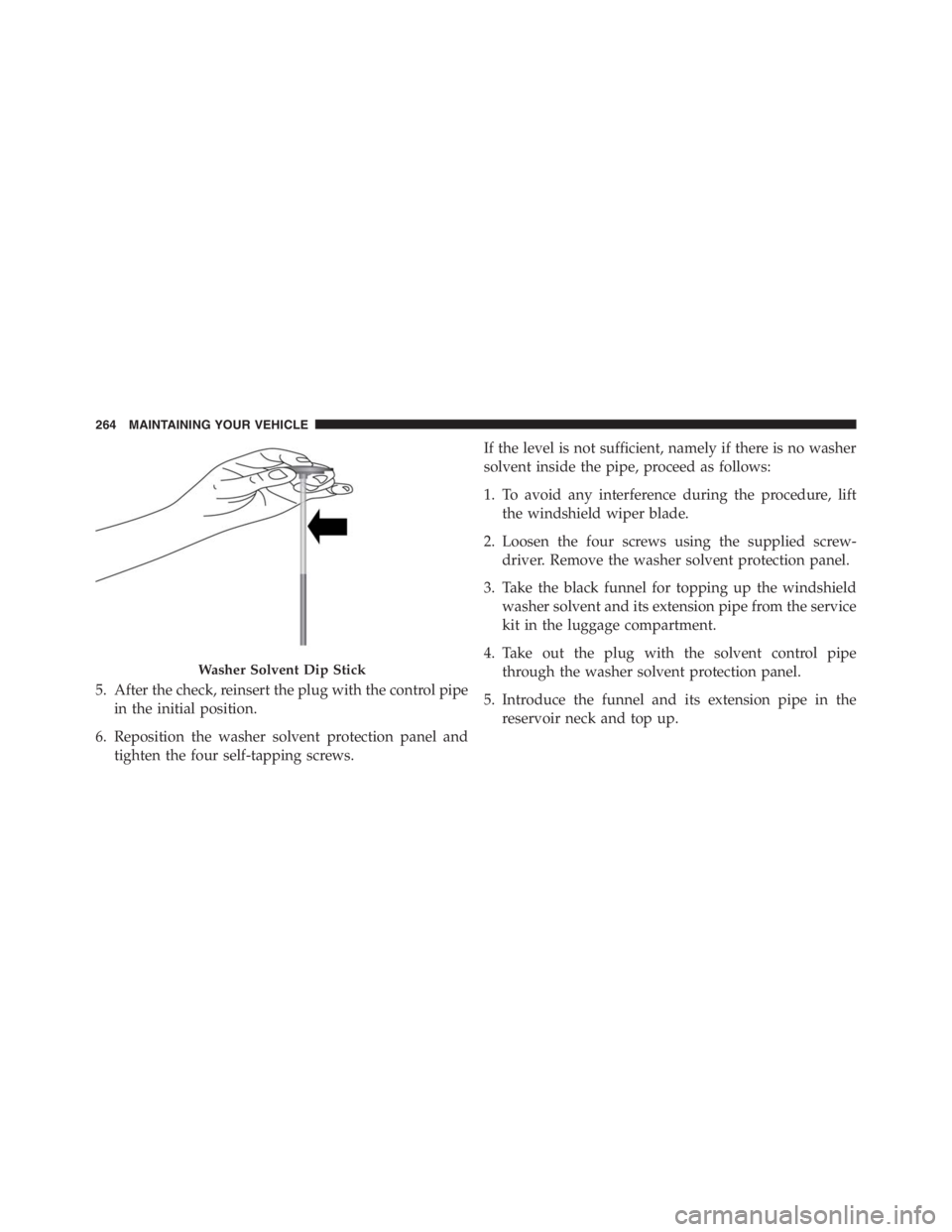
5. After the check, reinsert the plug with the control pipe
in the initial position.
6. Reposition the washer solvent protection panel and
tighten the four self-tapping screws.If the level is not sufficient, namely if there is no washer
solvent inside the pipe, proceed as follows:
1. To avoid any interference during the procedure, lift
the windshield wiper blade.
2. Loosen the four screws using the supplied screw-
driver. Remove the washer solvent protection panel.
3. Take the black funnel for topping up the windshield
washer solvent and its extension pipe from the service
kit in the luggage compartment.
4. Take out the plug with the solvent control pipe
through the washer solvent protection panel.
5. Introduce the funnel and its extension pipe in the
reservoir neck and top up.
Washer Solvent Dip Stick
264 MAINTAINING YOUR VEHICLE
Page 267 of 348
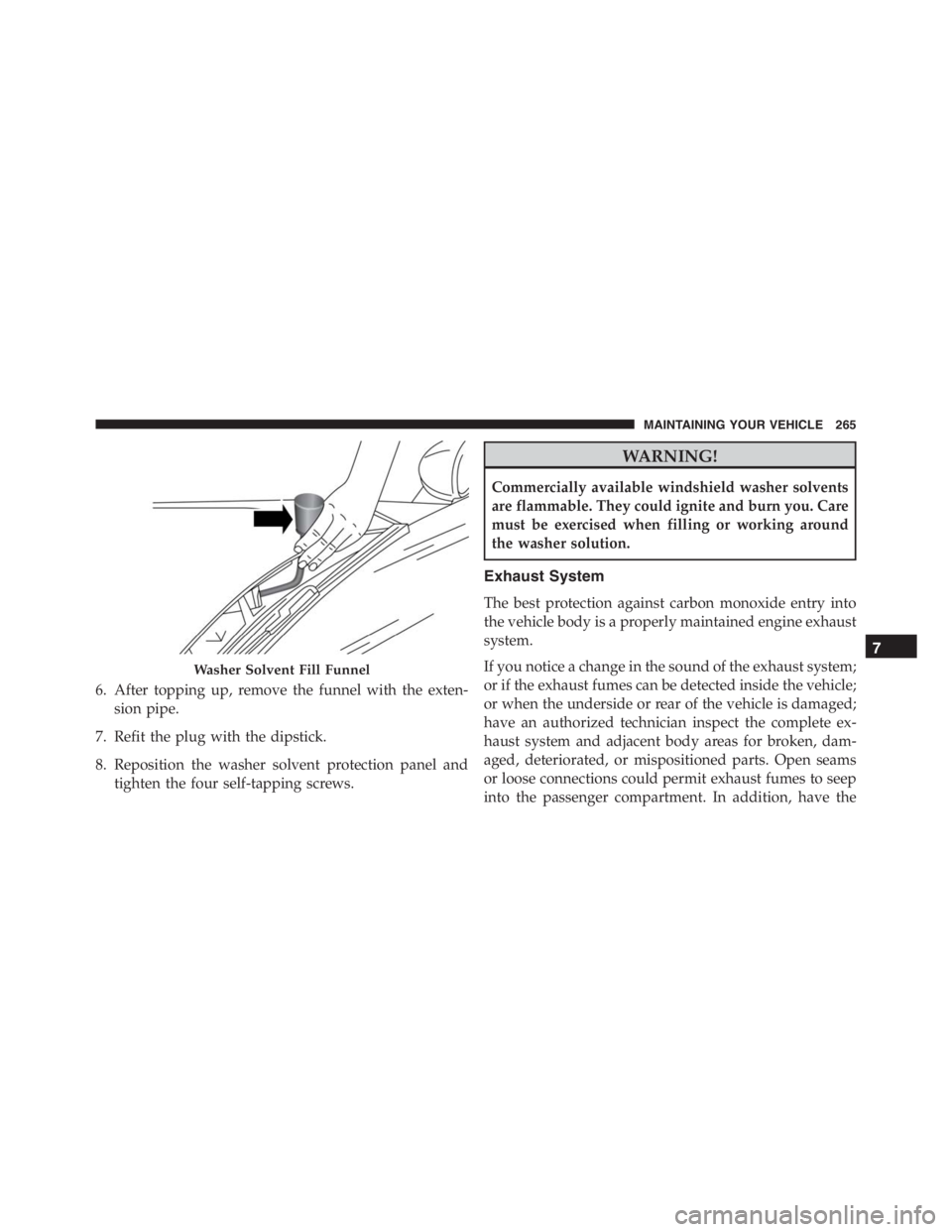
6. After topping up, remove the funnel with the exten-
sion pipe.
7. Refit the plug with the dipstick.
8. Reposition the washer solvent protection panel and
tighten the four self-tapping screws.
WARNING!
Commercially available windshield washer solvents
are flammable. They could ignite and burn you. Care
must be exercised when filling or working around
the washer solution.
Exhaust System
The best protection against carbon monoxide entry into
the vehicle body is a properly maintained engine exhaust
system.
If you notice a change in the sound of the exhaust system;
or if the exhaust fumes can be detected inside the vehicle;
or when the underside or rear of the vehicle is damaged;
have an authorized technician inspect the complete ex-
haust system and adjacent body areas for broken, dam-
aged, deteriorated, or mispositioned parts. Open seams
or loose connections could permit exhaust fumes to seep
into the passenger compartment. In addition, have the
Washer Solvent Fill Funnel
7
MAINTAINING YOUR VEHICLE 265
Page 268 of 348
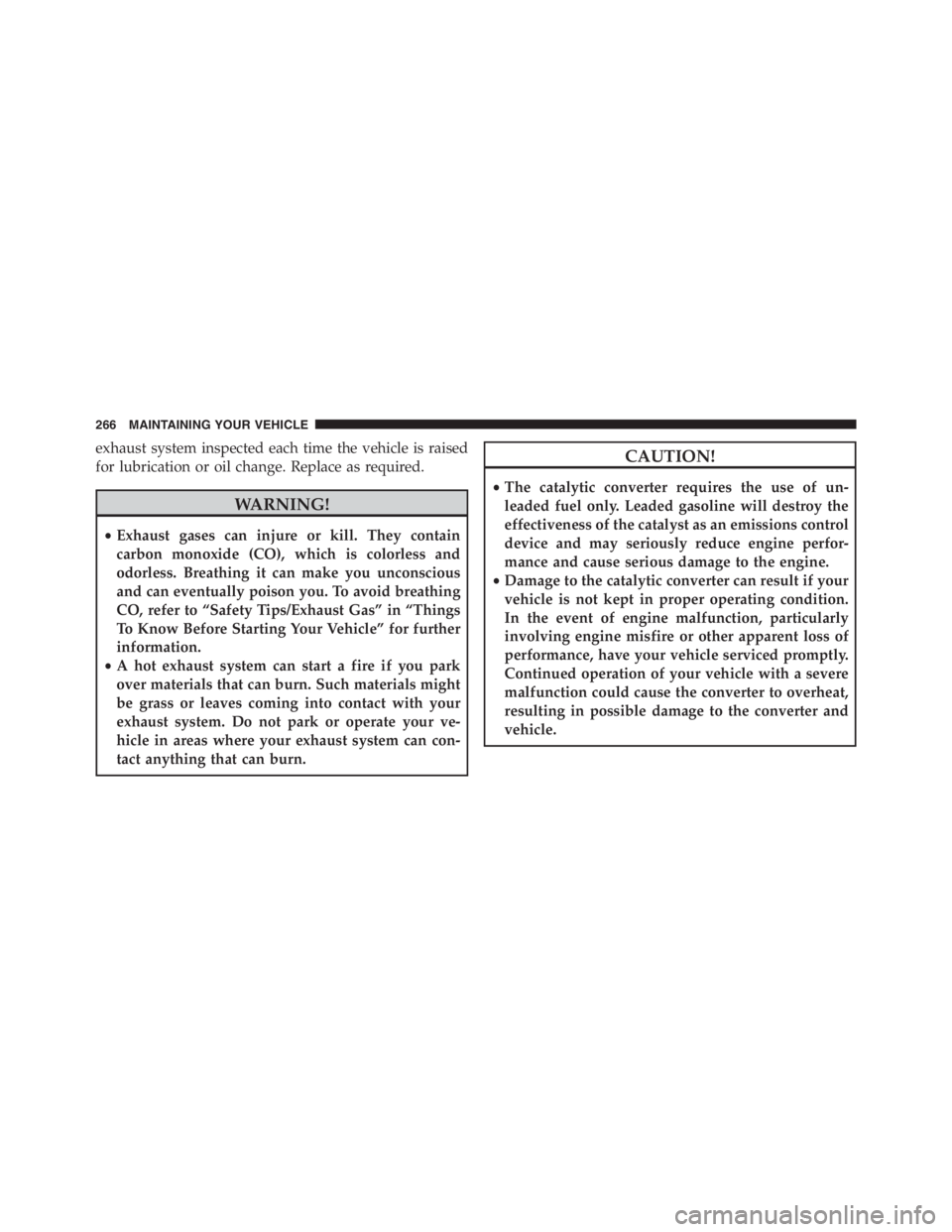
exhaust system inspected each time the vehicle is raised
for lubrication or oil change. Replace as required.
WARNING!
•Exhaust gases can injure or kill. They contain
carbon monoxide (CO), which is colorless and
odorless. Breathing it can make you unconscious
and can eventually poison you. To avoid breathing
CO, refer to “Safety Tips/Exhaust Gas” in “Things
To Know Before Starting Your Vehicle” for further
information.
•A hot exhaust system can start a fire if you park
over materials that can burn. Such materials might
be grass or leaves coming into contact with your
exhaust system. Do not park or operate your ve-
hicle in areas where your exhaust system can con-
tact anything that can burn.
CAUTION!
•The catalytic converter requires the use of un-
leaded fuel only. Leaded gasoline will destroy the
effectiveness of the catalyst as an emissions control
device and may seriously reduce engine perfor-
mance and cause serious damage to the engine.
•Damage to the catalytic converter can result if your
vehicle is not kept in proper operating condition.
In the event of engine malfunction, particularly
involving engine misfire or other apparent loss of
performance, have your vehicle serviced promptly.
Continued operation of your vehicle with a severe
malfunction could cause the converter to overheat,
resulting in possible damage to the converter and
vehicle.
266 MAINTAINING YOUR VEHICLE
Page 269 of 348

Under normal operating conditions, the catalytic con-
verter will not require maintenance. However, it is im-
portant to keep the engine properly tuned to assure
proper catalyst operation and prevent possible catalyst
damage.
NOTE:Intentional tampering with emissions control
systems can result in civil penalties being assessed
against you.
In unusual situations involving grossly malfunctioning
engine operation, a scorching odor may suggest severe
and abnormal catalyst overheating. If this occurs, stop
the vehicle, turn off the engine and allow it to cool.
Service, including a tune-up to manufacturer’s specifica-
tions, should be obtained immediately.To minimize the possibility of catalytic converter dam-
age:
•Do not shut off the engine or interrupt the ignition,
when the transmission is in gear and the vehicle is in
motion.
•Do not try to start the engine by pushing or towing the
vehicle.
•Do not idle the engine with any spark plug wires
disconnected or removed, such as when diagnostic
testing, or for prolonged periods during very rough
idle or malfunctioning operating conditions.
7
MAINTAINING YOUR VEHICLE 267
Page 270 of 348
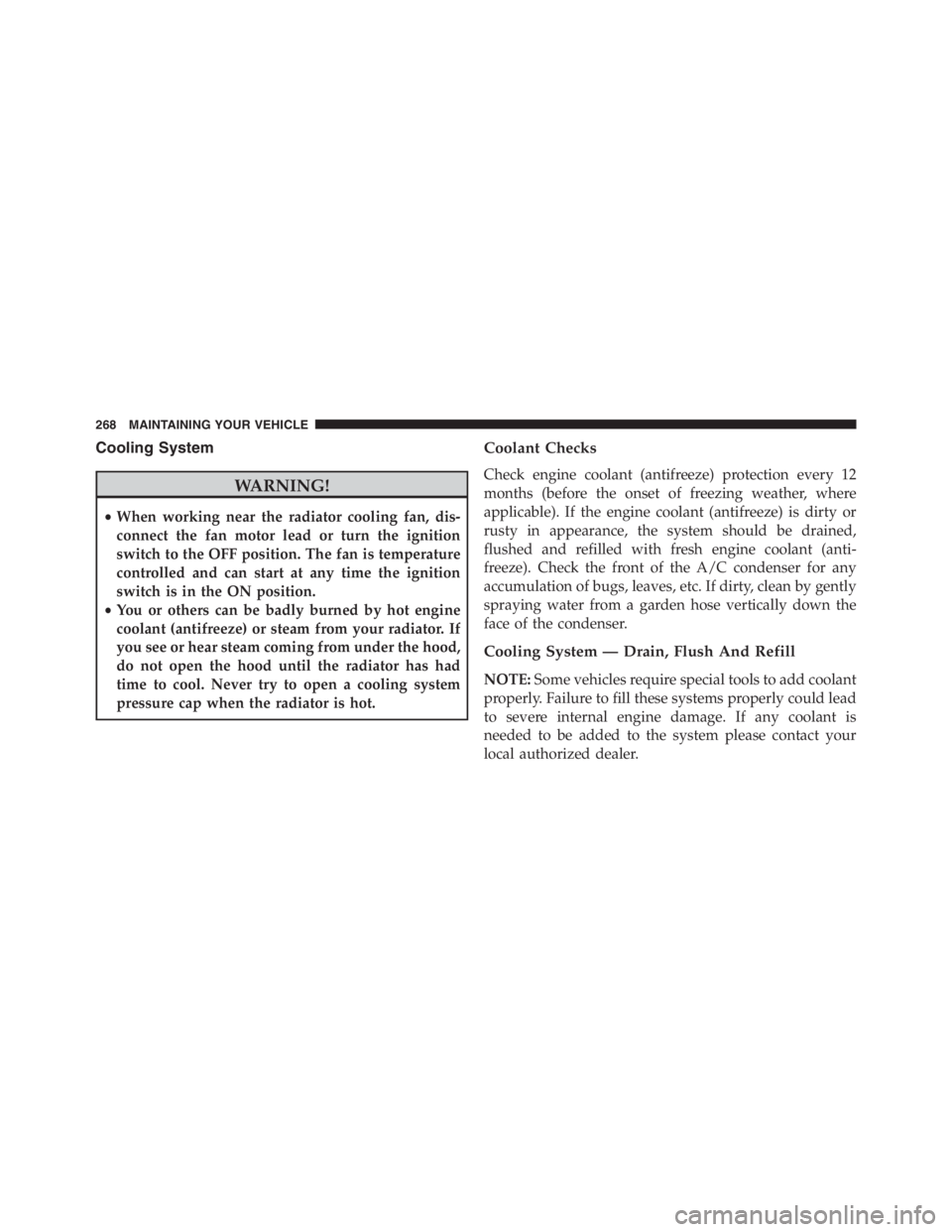
Cooling System
WARNING!
•When working near the radiator cooling fan, dis-
connect the fan motor lead or turn the ignition
switch to the OFF position. The fan is temperature
controlled and can start at any time the ignition
switch is in the ON position.
•You or others can be badly burned by hot engine
coolant (antifreeze) or steam from your radiator. If
you see or hear steam coming from under the hood,
do not open the hood until the radiator has had
time to cool. Never try to open a cooling system
pressure cap when the radiator is hot.
Coolant Checks
Check engine coolant (antifreeze) protection every 12
months (before the onset of freezing weather, where
applicable). If the engine coolant (antifreeze) is dirty or
rusty in appearance, the system should be drained,
flushed and refilled with fresh engine coolant (anti-
freeze). Check the front of the A/C condenser for any
accumulation of bugs, leaves, etc. If dirty, clean by gently
spraying water from a garden hose vertically down the
face of the condenser.
Cooling System — Drain, Flush And Refill
NOTE:Some vehicles require special tools to add coolant
properly. Failure to fill these systems properly could lead
to severe internal engine damage. If any coolant is
needed to be added to the system please contact your
local authorized dealer.
268 MAINTAINING YOUR VEHICLE